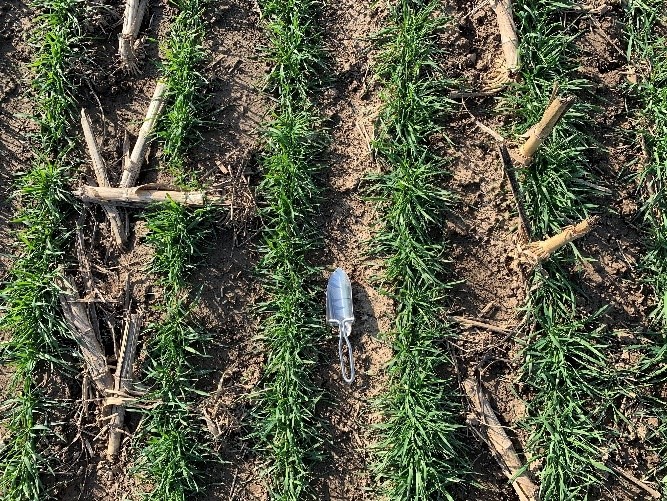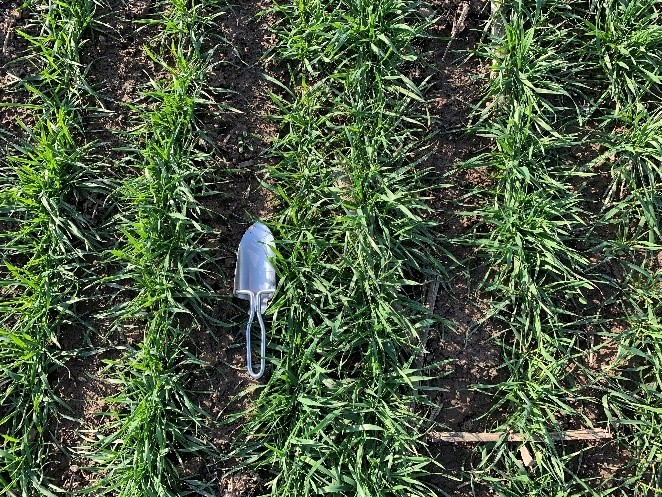Summary:
A winter wheat research trial was initiated in the fall of 2020 looking at different drill technology, row width and starter fertilizer response. Six different drill and fertilizer combinations were assessed and replicated three times across the field for a total of 18 treatments. A 10” row Sunflower no-till drill, 7.5” row JD no-till drill, 7.5” row JD no-till drill with SeederForceTM and a Borgault drill were assessed along with various MAP, MESZ and no starter treatments. On July 30th the plot was harvested and the average yield across all treatments was 131 bu/ac. There were no statistical differences across treatments meaning there was no response to the SeederForceTM technology, seed place fertilizer or narrower row width. This trial is limited to one location in one year so multi-year and location data is needed.
Purpose:
There has been significant work done exploring phosphorus response in winter wheat, row spacing and more recently row opener down pressure adjustment. Knowing the importance of getting wheat off to a great start to optimize yields, a research trial was initiated in the fall of 2020 to answer a common question, what is the most economical way to get wheat in the ground and off to a good start if working with older equipment? Specifically, does it pay to rent a high-performance drill or pay a custom operator to plant your wheat. The project grew to answer even more questions, such as is SeederForceTM and other new drill technology worth the investment and what about MESZ vs MAP? A 10” row Sunflower no-till drill was the main drill being used on this operation and was used as our starting point (Figure 1).

Method:
This trial was seeded after corn silage harvest on September 16th with Pioneer R61 a rate of 1.6 M seeds/ac. The field has a history of alfalfa in the rotation as well as dairy and hog manure applications. Soil test levels for this sandy loam soil were high with phosphorus levels at 55 ppm, potassium at 188 ppm and an organic matter level of 5.1%. Six different drill and fertilizer combinations were assessed and replicated three times across the field for a total of 18 treatment strips (Table 1). All strips were 30 feet wide and over 2000 ft long.
Table 1: Treatment list by drill type, row width, and fertilizer applied.
| Treatment # | Drill Type | Row Width (inches) | Fertilizer Applied (lbs actual/ac) | Method Applied |
| 1 | JD Drill – SeederForceTM | 7.5 | 100 lbs/ac MAP | In-furrow |
| 2 | Borgault Drill | 7.5 | 100 lbs/ac MAP | In-furrow |
| 3 | Borgault Drill | 7.5 | 100 lbs/ac MESZ | In-furrow |
| 4 | Sunflower No-till Drill | 10 | 100 lbs/ac MAP | Mixed directly with seed |
| 5 | JD Drill – SeederForceTM | 7.5 | No starter applied | N/A |
| 6 | JD No-till Drill No SeederForceTM | 7.5 | 100 lbs/ac MAP | Mixed directly with seed |
In the spring, a herbicide and T1 fungicide were applied tankmixed for weed control and heavy powdery mildew pressure. A T3 fungicide was also applied at heading to reduce the risk of fusarium head blight infection following seeding after corn silage. 150 lbs/ac of actual nitrogen was applied in the form of 28% at GS 31 and a plant growth regulator was applied to help manage lodging.


Results:
Early planting and an open fall allowed for significant growing degree day (GDD) accumulations at this location in the fall. The wheat emerged in 9 days on September 25, 2020. From September 16th to December 31st, approximately 620 GDDs were accumulated with 450 of those GDDs being accumulated before the end of October. This resulted in quick emergence, significant tillering and root growth prior to winter.



Figure 5 and 6: 10” rows on the left and 7.5” rows on the right. Growth and distribution of plants is more uniform in the 7.5” SeederForceTM treatment vs 10” sunflower treatment in November 2020.
Overall, the winter months were mild with minimal freeze-thaw events resulting in little to no winter loss. March was warm, followed by a cool and wet April, and then turned dry for the month of May which saw a total of 30 mm (1.25”) of rainfall. In the month of June there was a total of 87 mm (3.4”) of rainfall. However, over 30% of that rainfall was received in one event on June 25th bringing 29.7mm (1.17”) and a significant amount of wind. As a result, a large portion of the field lodged and remained that way for the remainder of the growing season (Figure 6).


Assessment scores were taken at the time of lodging and at harvest. Table 2 highlights the average % of the plot that was lodged at harvest for each treatment. The average plant height across all treatments was 90 cm (35”).
Table 2: Percent lodging across treatments at harvest on July 30th.
| Treatment # | Drill Type | Row Width (inches) | Average % Lodged |
| 1 | JD Drill – SeederForceTM | 7.5 | 50 |
| 2 | Borgault – MAP | 7.5 | 55 |
| 3 | Borgault – MESZ | 7.5 | 53 |
| 4 | Sunflower No-till Drill | 10 | 52 |
| 5 | JD Drill – SeederForceTM (No Starter) | 7.5 | 58 |
| 6 | JD No-till Drill No SeederForceTM | 7.5 | 57 |
On July 30th the plot was harvested and despite the lack of moisture in May to the end of June and significant lodging across treatments, yields were excellent (Table 3). There were no statistical differences across treatments. Meaning there was no response to the SeederForceTM technology, seed place fertilizer or narrower row width. The analysis showed very little within field variation, but we saw a lot of variation in treatment strip weights which likely contributed to the lack of treatment effects found.
Table 3: Yield results (bu/ac)
| Treatment # | Drill Type | Average Yield (bu/ac) | Average Falling Number |
| 1 | JD Drill – SeederForceTM | 134a | 129 a |
| 2 | Borgault – MAP | 129a | 126 a |
| 3 | Borgault – MESZ | 124a | 129 a |
| 4 | Sunflower No-till Drill | 128a | 138 a |
| 5 | JD Drill – SeederForceTM (No Starter) | 137a | 123 a |
| 6 | JD No-till Drill No SeederForceTM | 131a | 134 a |
Discussion:
Drill Type:
More research is required to fully assess the impact of the different drill technology. This plot was seeded early in the season which likely played a role in the excellent yields overall. On years like this, where wheat is seeded early, is well established prior to winter and experiences minimal winter losses, the advantage of down pressure is not seen. Additional research looking at later planting dates should be considered as it is hypothesized the technology would be advantageous in those scenarios.
Starter Fertilizer:
There was no response to starter fertilizer at this location regardless of the product applied. This is likely due to the fact that soil P and K levels were so high to begin with. This is consistent with previous Ontario research where we see a lower response in high testing soils. Again, research on lower testing soils would be advantageous.
Row Width:
There was no advantage to 7.5” row widths vs 10” rows at this location. The early planting likely played a role in allowing the plants to tiller well before winter and achieve canopy closure early in the spring regardless of treatment. This helps optimize solar radiation capture.
The significant lodging that occurred during the grain-fill period may have also contributed to the NSD treatment effects found in this study.
Economics:
While in this scenario there was no advantage to some of the newer drill technology when planting early on a soil with high soil test levels, in other years there may be an advantage. Particularly when planting beyond the optimum seeding date for a region. The rental of the JD drill with 7.5” row spacing was $14/ac in this scenario. That means it would take less than 2 bu/ac more yield then the 10” Sunflower drill to pay for the cost of the drill rental at a price of $8.00/bu. If the price of wheat was as low as $5.00/bu it would take less than 3 bu/ac to pay for the drill rental. This may be an option to explore in years where the planting date is being pushed later than ideal timing or when working with older drill technology or wider row spacing that is not reliable. When looking at the SeederForceTM technology and using a cost of $900 + labour per row, it would cost approximately $10,800 + labour to equip a 12-row drill. This technology may be an option to explore as a long term investment if planting is often being pushed beyond the optimum seeding window, there is difficulty cutting through residue during seeding, you are a custom operator and are covering a significant amount of acres or you have a drill in good shape that you would like to upgrade vs purchasing a completely new piece of equipment.
At the end of the day, it is important to make a decision that is best suited to the needs of each specific operation. There are multiple factors to consider that are likely going to be different between operations. Things like how often wheat is actually being seeded within the optimum planting window, the number of acres being grown, accessibility to rental equipment or a custom operator are all things to consider. When making large investment decisions, consider multi location and multi-year data.

2 thoughts on “2021 Drill Demo Results”
Comments are closed.